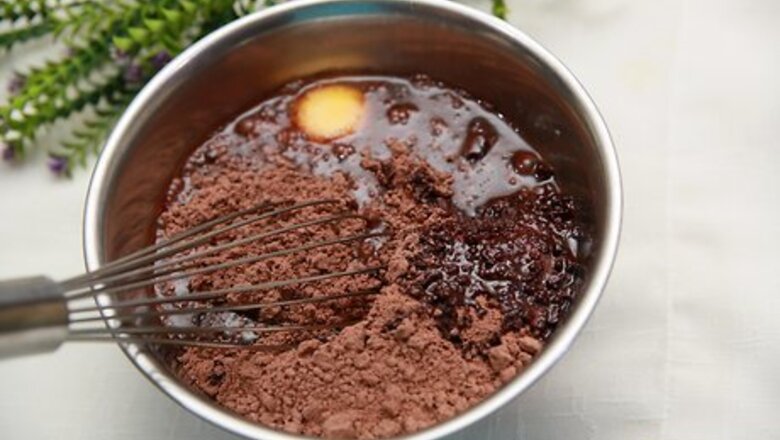
views
Preparing the Batter and Pan

Mix your cake batter. Follow your favorite cake recipe or combine a boxed cake mix according to the instructions on the box. You won't need to make any adjustments to the batter.
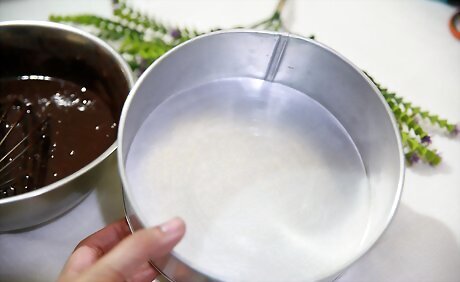
Select a baking pan. You can use a metal, pyrex glass, or silicone baking pan as long as it will fit in your pressure cooker. Consider using the following sizes depending on the size of your pressure cooker: 3-quart (2.8 L) cooker: 3 in × 3 in (7.6 cm × 7.6 cm), 4 in × 3 in (10.2 cm × 7.6 cm), 4 in × 4 in (10 cm × 10 cm), 5 in × 3 in (12.7 cm × 7.6 cm), 6 in × 3 in (15.2 cm × 7.6 cm) 6-quart (5.7 L) cooker: 3 in × 3 in (7.6 cm × 7.6 cm), 4 in × 3 in (10.2 cm × 7.6 cm), 4 in × 4 in (10 cm × 10 cm), 5 in × 3 in (12.7 cm × 7.6 cm), 5 in × 5 in (13 cm × 13 cm), 6 in × 3 in (15.2 cm × 7.6 cm), 7 in × 4 in (18 cm × 10 cm) 8-quart (7.6 L) cooker: 3 in × 3 in (7.6 cm × 7.6 cm), 4 in × 3 in (10.2 cm × 7.6 cm), 4 in × 4 in (10 cm × 10 cm), 5 in × 3 in (12.7 cm × 7.6 cm), 5 in × 5 in (13 cm × 13 cm), 6 in × 3 in (15.2 cm × 7.6 cm), 7 in × 4 in (18 cm × 10 cm), 8 in × 3 in (20.3 cm × 7.6 cm), 8 in × 4 in (20 cm × 10 cm)
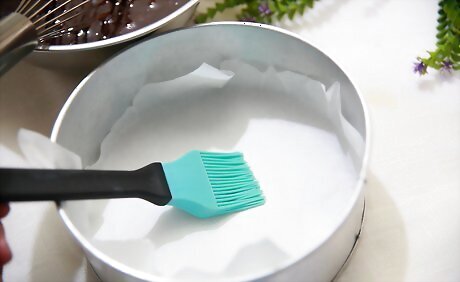
Grease the baking pan. Spray a round or square cake pan with cooking spray. If you don't have cooking spray, rub shortening or butter along the bottom and sides of the pan. Sprinkle a few spoonfuls of flour over the shortening and tap the pan to distribute the flour. Shake the pan over the trash so excess flour falls out.

Fill the pan with the cake batter. Scoop all of the cake batter into the prepared baking dish. Use the back of a spoon or an offset spatula to spread the batter so it's level in the pan.
Using a Stove-Top Pressure Cooker
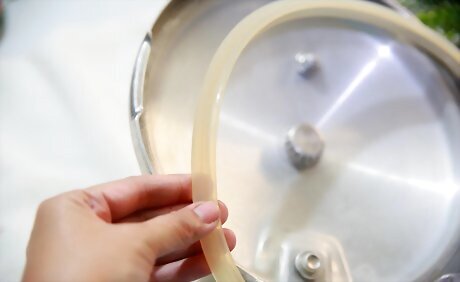
Remove the gasket and whistle from the pressure cooker. Since you won't be using water in the pressure cooker, you don't need the gasket. Pull off the rubber insulation from the lid and set it aside. You can also set the whistle aside. While you usually need to add water to the pressure cooker, if you leave the water out, you'll be baking instead of steaming. Only use this method if you have a stainless steel or aluminum stove top pressure cooker.
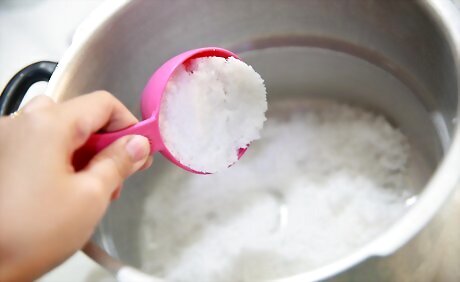
Place 1 1/2 cups (300 g) of salt in the pressure cooker. Spread the salt evenly in the bottom of the pressure cooker. The salt will insulate the cooker since you won't be using water.
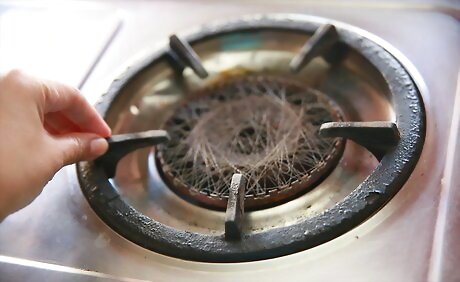
Set a stand in the bottom of the pressure cooker. Put a metal stand in the bottom of the cooker to distribute the heat and prevent the cake from burning on the bottom. If you don't have a stand, set a wire rack in the bottom of the cooker.
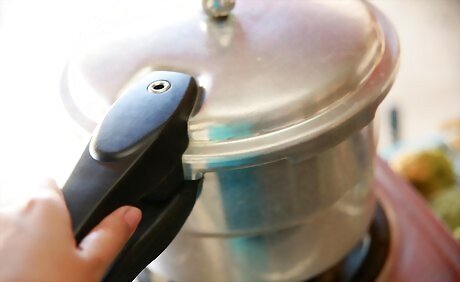
Preheat the empty pressure cooker on high for 2 minutes. Put the lid on the pressure cooker and turn the burner to high. Let the pressure cooker heat before you add the pan with the batter.
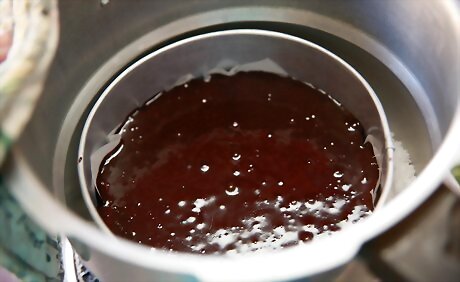
Lower the cake pan into the pressure cooker and put the lid on. Wear oven mitts to lift the lid off of the hot pressure cooker. Carefully lower the pan with the cake batter down onto the stand in the pressure cooker. Put the lid on the cooker.

Reduce the heat to medium and cook the cake for 5 minutes. The cake will immediately begin to rise and cook.
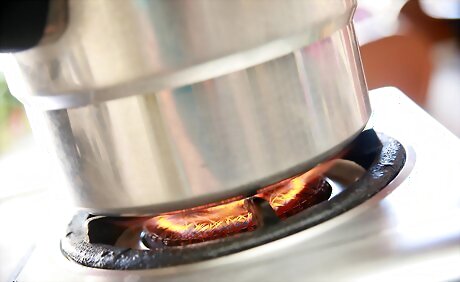
Turn the burner to low and bake the cake according to the recipe. Because you aren't actually cooking with pressure, the cake will take about the same time to bake as if you were baking it in a standard oven. Follow the bake time instructions from your recipe or the back of the box mix.

Check the cake. To test if the cake is finished baking, insert a toothpick or cake tester into the center of the cake. If it comes out clean, turn off the burner. If not, check the cake again in 3 to 5 minutes.
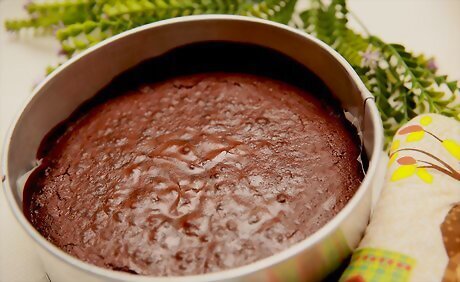
Cool and remove the cake from the pan. Let the cake cool and lift it up and out of the pressure cooker.
Using an Electric Pressure Cooker
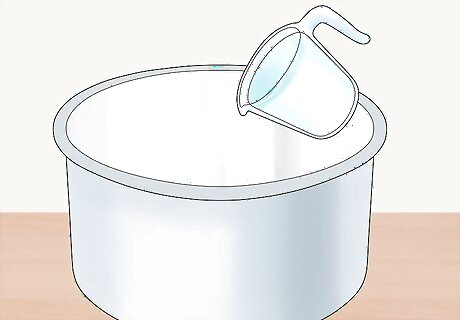
Pour 1 cup (240 ml) of water in the insert. Once you've poured the water into the insert, set a metal trivet into the bottom so your cake pan won't come into direct contact with the insert.
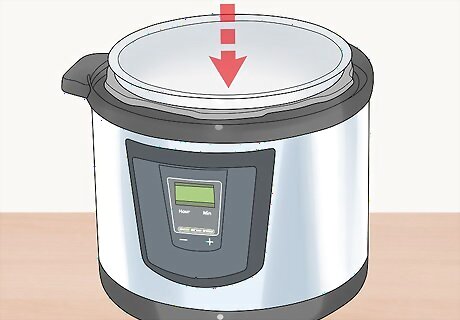
Lower the pan into the cooker. The filled cake pan should be sitting on the metal trivet.
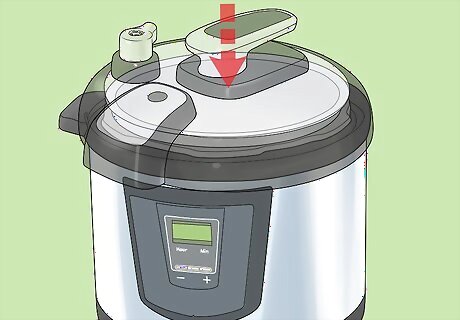
Put the lid on the cooker and seal it shut. Set the lid on the pressure cooker and turn it clockwise until it's fastened in place. Most pressure cookers won't work until the lid is properly tightened.
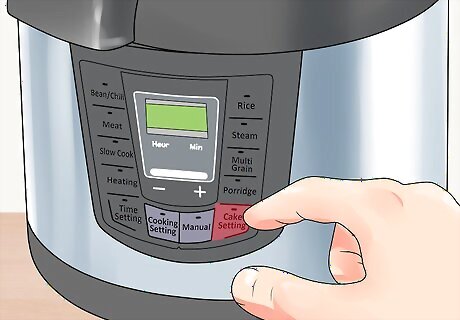
Set the cooker to the cake or high setting. Turn the pressure cooker on and select the cake program setting. If your pressure cooker doesn't have this option, use the manual setting to pressure cook on high.

Adjust the temperature according to the type of cake you're making. If you're making a light, moist cake such as a sponge, turn the temperature to "Less." Most standard cakes or cake mixes are fine on the normal temperature setting. If you're cooking a dense cake, brownie, or cheesecake, increase the temperature to "More."

Set the bake time for half of the normal time. Check the recipe or box instructions for how long to cook the cake according to the size pan you're using. Take the amount of time given and set the pressure cooker for half of the time. For example, if your recipe calls for a 50 minute cook time, program the pressure cooker for 25 minutes.

Release the pressure for 10 minutes. As the pressure cooker cools down, the pressure will reduce on its own. Once the float valve has dropped down, you can turn the lid counterclockwise and lift it off.
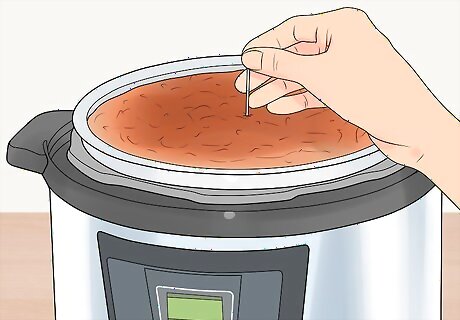
Check the cake for doneness. To test the cake, insert a toothpick into the center of the cake. If it comes out clean, the cake has finished cooking. It can take anywhere from 10 to 40 minutes for the pressure to release, depending on the size of your pressure cooker. If the cake isn't done, you'll need to put the lid back on and turn the pressure cooker back on. Check it again after 5 minutes of pressure cooking.

Let your cake cool for 5 minutes and lift it out. Give the pan a chance to cool a little before you take it out of the pressure cooker. You can wear oven mitts and pick the cake pan up or use 2 pairs of tongs to pull the pan out. Set the cake on a wire rack to finish cooling completely.



















Comments
0 comment